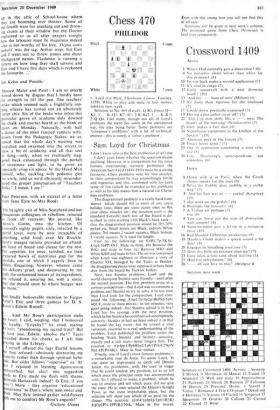Chess 470
PHILIDOR
S. Loyd ( St Prize, Charleston Courier Tourney, 1859). White to play and mate in four moves; solution next week
Solution to No. 469 (Loyd): Q-RI, threat Q- Kl. 1 K-Q7, K7, B7; 2 R-Kt2. 1 ... K-K5; 2 Q-Q4. Like many, though not all, of Loyd's problems the merit lies solely in the unexpected key, the play being banal. Some problems are 'composer's problems' with a lot of technical interestāthis is purely a 'solver's problem'.
Sam Loyd for Christmas
I don't know who is the best problemist of all time ā1 don't even know whether the question means anything. However in a competition for the most human, entertaining, warmest problemist the American Sam Loyd (1841-1911) must be a strong favourite. Chess problems were for him puzzles; in their composition he was astonishingly fertile and ingenious and this, combined with his keen sense of fun (which he extended to his problems as well as his life) makes him a natural for Christ- mas problems.
The diagrammed problem is a really hard four- mover, which should fill in most of any spare holiday time. Here are some easier ones to flex your chess muscles onāthe notation used is the standard Forsyth; each row of the board is de- scribed in turn starting with Black's back rankā thus the diagrammed position would be 2b5/2P5/ pplp4 etc. Small letters are Black, capitals White pieces; 2b5 means 2 vacant squares, Black bishop, 5 vacant squares. N is used for knight.
First try the following: (a) 8/6R1/7p/5K1k/ 8/6p1/5bPP/4N3. Mate in three. (b) Remove the WKt and mate in four. (c) Remove WKt and White KRP and mate in five. The set was composed when Loyd was eighteen to illustrate a story of Charles XII, besieged by the Turks at Bender; the disappearing pieces were supposed to have been shot from the board by Turkish bullets.
Next, two Steinitz problems; Loyd and the world champion Steinitz were friendlyāuntil after the second position. The first problem arose in a curious competitionāthat Loyd was to compose a problem and Steinitz to try to solve it in less time than Loyd took for the composition. Loyd com- posed the following: 8/6p1/7p/4p2p/4KPkp/6p1/ 6Q1/8, mate in three movesāin ten minutes; very good going indeedābut Steinitz solved it in five! Loyd has his revenge with the next position, which he bet Stei nitz he could not sol ve co mpletely correctly; Steinitz in half an hour solved it in that he found the key moveābut he missed a vital variation, essential to a real understanding of the problem. Loyd published the problem under the heading 'Stuck Steinitz' and Steinitzāsensitive, moody and a sick manānever forgave him. The position is: 8/p4pp I /PpbB1p2/ p6/ I PI k 4/2NpN Ppl/IPIP4/6KI. Mate in four moves.
Finally, one of Loyd's most famous problemsā a remarkable tour de force. To quote Loyd, 'It was quite an impromptu to catch old Dennis Julien, the problemist, with. He used to wager that he could analyse any position, so as to tell which piece the principal mate was accomplished with. So I offered to make a problem, which he was to analyse and tell which piece did not give the mate. He at once selected the Queen's Knight Pawn as the most improbable piece, but the solution will show you which of us paid for the dinner. The position: nIrb4/1p3p1p/Ip6/1R5K/ 8/p3p1PN/ I PP1R3/N6L Mate in five moves.
Even with this strong hint you will not find this at all easy.
Solutions will be given in next week's column. The promised game from Chess Olympiads is held over temporarily.


































 Previous page
Previous page